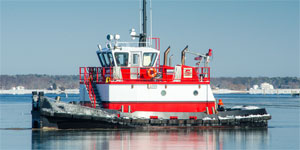It was early March and 20 degrees on the Potomac River, but Capt. Steve McLaughlin was sweating. Fully licensed but working that day as a deck hand on the tug Capt. Kenneth, McLaughlin was struggling with a thick barge line, heavy with ice, across the rail. He slipped the tug’s line through the loop, ran it through the bull nose and made fast to the tug’s stainless-steel bitt.
“No matter what license you have, a deck hand’s life is never easy,” he grunted.
Moran Towing’s 120-foot Joan Moran had towed the empty hopper barge up the Chesapeake Bay from Norfolk. The two tugs, now in concert, tripped the barge around, moved it parallel to a power plant’s dock and eased it up against the pilings. The Moran crew made fast.
Moran has the tug and barge on a contract to transport the plant’s recovered fly ash to a facility that uses it to replace the cement in gypsum board. Capt. Kenneth was contracted to Moran as the assist tug.
Capt. Kenneth was designed by the late Oliver Bryant of Pascagoula, Miss., and built over a three-year period at the Smith Brothers yard in Galesville, Md. The tug is named for Kenneth Smith, a centenarian and the last of seven Smith brothers working in the company. His son, Jeffery, is president of the company that concentrates on truckable tugs and sectional barge rentals along with towing services in Chesapeake Bay.
“We’re a happy little company in a small town and we grow a little bit every year,” said Capt. Preston Hartge, Smith Brothers’ general manager.
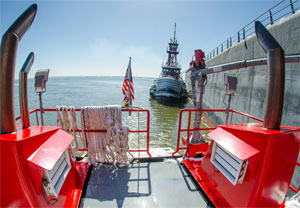 |
|
The vessel’s bright new stacks frame the tugboat Joan Moran. |
Hartge supervised the building of Capt. Kenneth. “The boat’s shallow draft allows her to get into places other boats can’t,” he said. “Four to 6 feet is a good operating draft for us and right now we are full of fuel and water, so she’s about 6 feet.”
Although a model bow style tug, Capt. Kenneth is unusual because it has push knees set close together, bookending a small bull nose on the stem. The knees make for a more solid face-up with a barge. That’s especially useful in nasty winter weather on the Chesapeake. There is a stainless-steel bitt and two Nabrico DF-156 hydraulic-electric 22-ton face-wire winches on the bow. For towing there is a stainless-steel H-bitt and a 7.5-hp capstan on the stern.
Capt. Kenneth, at 49.5 feet by 19 feet, is powered by twin 350-hp John Deere 6125 mains, with ZF 325W marine gears at a 3.5:1 ratio turning Kaplan 40-by-42-inch propellers in CNF type 37 Kort nozzles. The engine and steering controls were supplied by Kobelt.
“We like the extra power we get with the Kort nozzles,” said Hartge. Hartge estimates the nozzles add 20 to 30 percent more propulsion. “I call it a solid 800-hp boat and the nozzles also give her real good stopping power.”
In order to ensure the tug would comply with the imminent Subchapter M regulations, Hartge collaborated closely with the Coast Guard. One feature, a fire control station, located at the entrance to the engine room from the galley, has clearly marked instructions so that anyone can shut down the engines, deploy fire suppression agents and starve the engine room of air.
The company installed an Incinolet head, a system that burns waste. “There are no water issues,” said Hartge. “The Kenneth is zero-discharge, with no black water at all.”
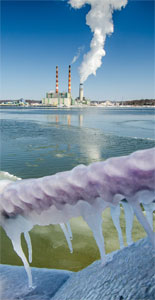 |
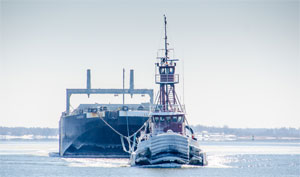 |
|
|
Ice builds up while Capt. Kenneth works the Potomac River near the Morgantown Generating Station. |
Joan Moran moves an empty barge to the power plant to load fly ash. |
|
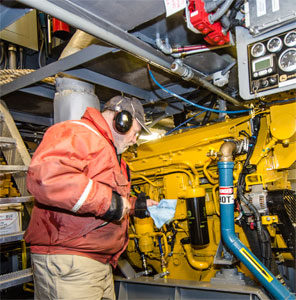 |
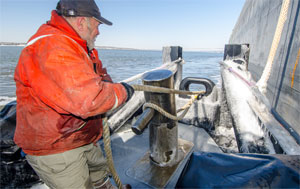 |
|
|
Capt. Steve McLaughlin with a John Deere 6125 engine. |
McLaughlin handles a very stiff line in the cold temperatures. |
|
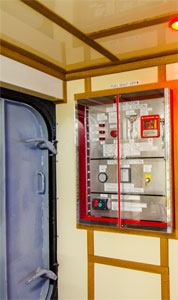 |
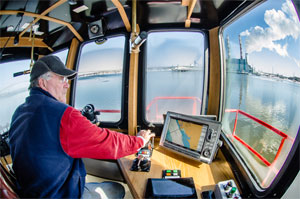 |
|
|
Capt. Kenneth’s fire control station at the entrance to the engine room. |
Capt. Preston Hartge is at the controls near the power plant. |

